What is the shoulder blade (scapula)?
The shoulder blades are two flat, symmetrical bones on each side of the top of your back [1]. The medical term for the shoulder blade is the scapula.
Scapula Function
The shoulder blades attach the upper arm and upper back muscles that raise your arms and shoulders and bend your neck backwards or sideways.
Scapula Location
Shoulder blades lie behind and medially to the shoulders, over the rib cage on each side of the spine; together with the clavicles, they form the shoulder girdle. They make joints with the upper arm bones (humerus) and collar bones (clavicle) but not with the ribs and spine. Shoulder blade pain can be felt over the large area of the upper back, though.
Picture 1. Scapula location:
on both sides of the upper back, under the muscles
Scapula Anatomy
Picture 2. The right scapula from the front and back side
The shoulder blade is a flat bone with three angles–the upper (superior), bottom (inferior) and lateral (glenoid) angle– and three borders–the superior, lateral (axillary) and medial (vertebral) border (Picture 3).
On the back side of the shoulder blade, at about two-thirds of its height, a bony ridge called the shoulder blade spine runs diagonally upwards toward the lateral angle and ends as a bony hook–the acromion–, which makes a bony roof of the shoulder joint. The part of the shoulder blade above the spine is called the supraspinous fossa and the one below the spine the infraspinous fossa. The other bony part, which sticks out from the upper front of the shoulder blade, is called the coracoid.
The frontal surface of the scapula is called the subscapular fossa.
Picture 3. Scapula anatomy diagram: parts of the right shoulder blade:
anterior, posterior and lateral aspect
The upper side part of the shoulder blade is called the glenoid cavity, which makes a joint with the upper arm bone–the glenohumeral joint. The acromion makes a joint with a clavicle–the acromioclavicular joint (Picture 4).
Shoulder Girdle
Picture 4. Shoulder or pectoral girdle:
scapula, clavicle and related joints and ligaments
(an anterior–from the front–view)
Shoulder Blade Muscles
Picture 5. Muscles connected to the scapulas (shoulder blades)
(a posterior–from behind–view)
Muscles that Connect Scapula to SPINE
Trapezius
Trapezius is the biggest upper back muscle that lies between the scapula and the spine and between the scapula and the neck on both sides.
- Origin: Back of the skull, 7th cervical to 12th thoracic spinal vertebra
Insertion: Spine and acromion of the scapula, lateral third of clavicle - Function: Elevates, depresses, retracts (moves toward the spine) and upwardly rotates the scapula, bends the neck backwards
- Reference [2,3]
Rhomboid major
Rhomboid major and minor connect the medial scapular border and the thoracic spine.
- Origin: 2nd to 5th thoracic spinal vertebra
- Insertion: Lower two-thirds of medial border of the scapula
- Function: Retracts and elevates the medial border of the scapula, rotates lateral angle downwards
- Reference: [3]
Rhomboid minor
- Origin: 7th cervical to 1st thoracic spinal vertebra
- Insertion: Upper third of medial border of the scapula
- Function: Retracts and elevates medial border of the scapula, rotates lateral angle downwards
- Reference: [3]
Levator scapulae
Levator scapulae connects the upper (medial) scapular angle and the cervical spine.
- Origin: 1st to 4th cervical spinal vertebra
- Insertion: Upper part of medial border of the scapula
- Function: Elevates medial border of the scapula and rotates lateral angle downwards, bends neck to the side
- Reference: [3]
Picture 6. Muscles connected to the scapulas (shoulder blades)
(an anterior–from the front–view)
Muscles that Connect Scapula to RIBS
Serratus anterior
Serratus anterior is a deep muscle on each side of the chest – it moves the ribs upwards and thus assists in breathing.
- Origin: anterior surfaces of first 8 or 9 ribs
- Insertion: anterior surface of medial border of the scapula
- Function: abducts (protracts) the scapula, upwardly rotates it while abducting the upper arm, stabilizes the scapula by holding it to chest wall
- Reference: [3]
Pectoralis minor
Pectoralis minor lies in the front and medially to the shoulder joint.
- Origin: Anterior surfaces of the 3rd, 4th and 5th rib
- Insertion: Coracoid of scapulae
- Function: Draws the scapula forward and downward, elevates ribs (during breathing in)
- Reference: [3]
Muscles that Connect Scapula to ARM
Rotator cuff muscles (subscapularis, supraspinous, infraspinous and teres minor) embrace the shoulder joint.
Subscapularis
Subscapularis lies on the inner side of the scapula (between the scapula and the ribs).
- Origin: Front side (subscapular fossa) of the scapula
- Insertion: Upper, medial part of the upper arm bone (lesser tubercle of humerus)
- Function: Rotates the upper arm in shoulder medially (which results in backward rotation of the palm)
- Reference: [4]
Supraspinatus
Supraspinatus lies above the spine on the back side of the scapula and helps raise the arm sideways.
- Origin: Supraspinous fossa of the scapula
- Insertion: Superior aspect of greater tubercle of the upper arm bone
- Function: Helps the deltoid muscle to initiate the abduction (sideways raise) of the arm at shoulder
- Reference: [4]
Infraspinatus
Infraspinatus lies below the spine on the back side of the scapula and rotates the arm outwards.
- Origin: Infraspinous fossa of the scapula
- Insertion: Middle part of the greater tubercle of the upper arm bone
- Function: Laterally rotates arm in the shoulder (which results in forward rotation of the palm); it also helps stabilize the shoulder by drawing the upper arm toward the scapula
- Reference: [4]
Teres minor
Teres minor lies on the lower part of the back side of the scapula and rotates the arm outwards.
- Origin: Middle part of lateral border of the scapula
- Insertion: Inferior aspect of greater tubercle of humerus
- Functions: Laterally rotates and adducts (moves toward the body) the upper arm and helps stabilize the upper arm in the shoulder by drawing it toward the scapula
- Reference: [4]
Teres major
Teres minor lies on the lower part of the back side of the scapula and moves the arm toward the body.
- Origin: Lower lateral border and inferior angle of the scapula
- Insertion: Medial lip of the intertubercular (bicipital) groove of the anterior upper arm bone
- Function: Adducts (moves toward the body) the arm in the shoulder
- Reference: [4]
Deltoid (middle head)
The middle deltoid lies on the outer side of the shoulder.
- Origin: Acromion and the spine of the scapula
- Insertion: Deltoid tuberosity of the upper arm bone
- Function: Abducts (raises sideways) the arm in the shoulder
- Reference: [4]
Deltoid (posterior head)
The posterior deltoid lies at the back of the shoulder.
- Origin: Spine of the scapula
- Insertion: Deltoid tuberosity of the upper arm bone
- Function: Laterally rotates and extends backwards the arm in the shoulder
- Reference: [4]
Coracobrachialis
Coracobrachialis connects the upper part of the scapula and the lower end of the upper arm on the front side.
- Origin: Coracoid process of the scapula
- Insertion: Mid-medial surface of the upper arm bone
- Function: Flexes (forwards) the arm in the shoulder
- Reference: [4]
Biceps brachii
Biceps brachii lies between the upper part of the scapula and the upper part of the forearm on the inner (front) side of the arm.
- Origin of the long head: Supraglenoid tubercle (lateral angle) of the scapula
- Origin of the short head: Coracoid process of the scapula
- Insertion: Tuberosity of the radius (the thinner bone in the forearm)
- Function: Flexes the arm in the shoulder and elbow, supinates the forearm (which results in rotation of the palm upwards)
- Reference: [4]
Triceps brachii (long head)
Triceps brachii extends from the scapula and the upper part of the upper arm to the upper part of the forearm on the outer (back) side of the arm.
- Origin: Infraglenoid tubercle (lateral angle) of the scapula
- Insertion: Posteriour olecranon of the ulna (the thicker bone of the forearm)
- Function: Extends the upper arm backwards at the shoulder
- Reference: [4]
Muscles that Connect Scapula to Hyoid Bone
Omohyoid
Omohyoid runs from the middle front of the neck toward the upper border of the scapula.
- Origin: Suprascapular ligament and superior border of the scapula
- Insertion: Inferior border of hyoid bone
- Function: Depresses hyoid bone and hence larynx
- Reference: [5]
- References
- Henry Gray, Anatomy of the Human Body: The scapula (shoulder blade) Bartleby.com
- Henry Gray, Anatomy of the Human Body: Trapezius muscle Bartleby.com
- Muscles that act on the shoulder (trapezius, rhomboid major and minor, pectoralis minor, levator scapulae, serratus anterior) GetBodySmart
- Muscles that act on the arm GetBodySmart
- Omohyoid Loyola University, Medical Education Network


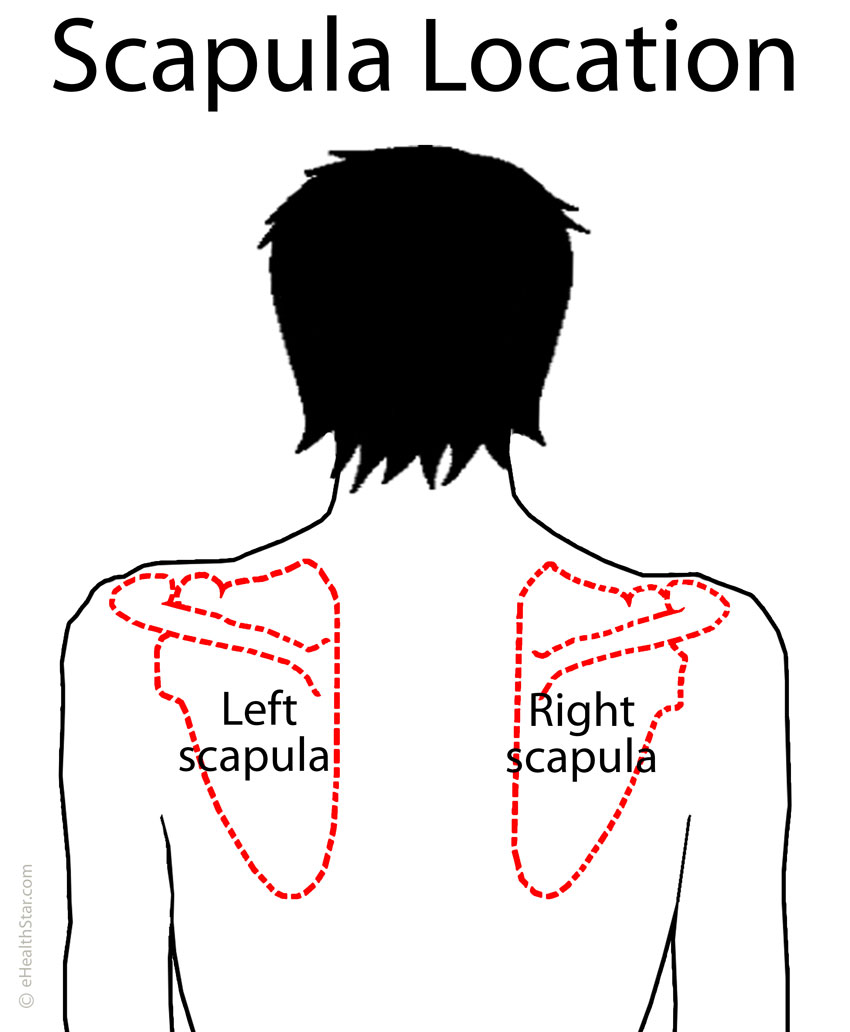
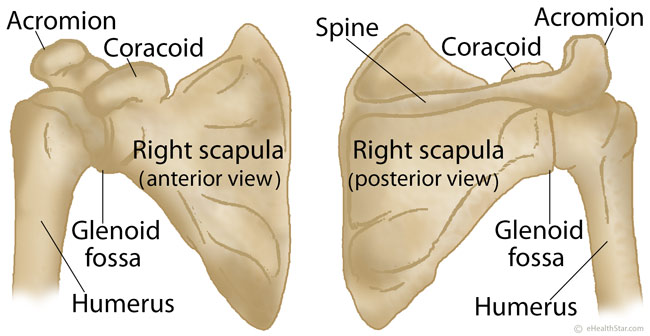
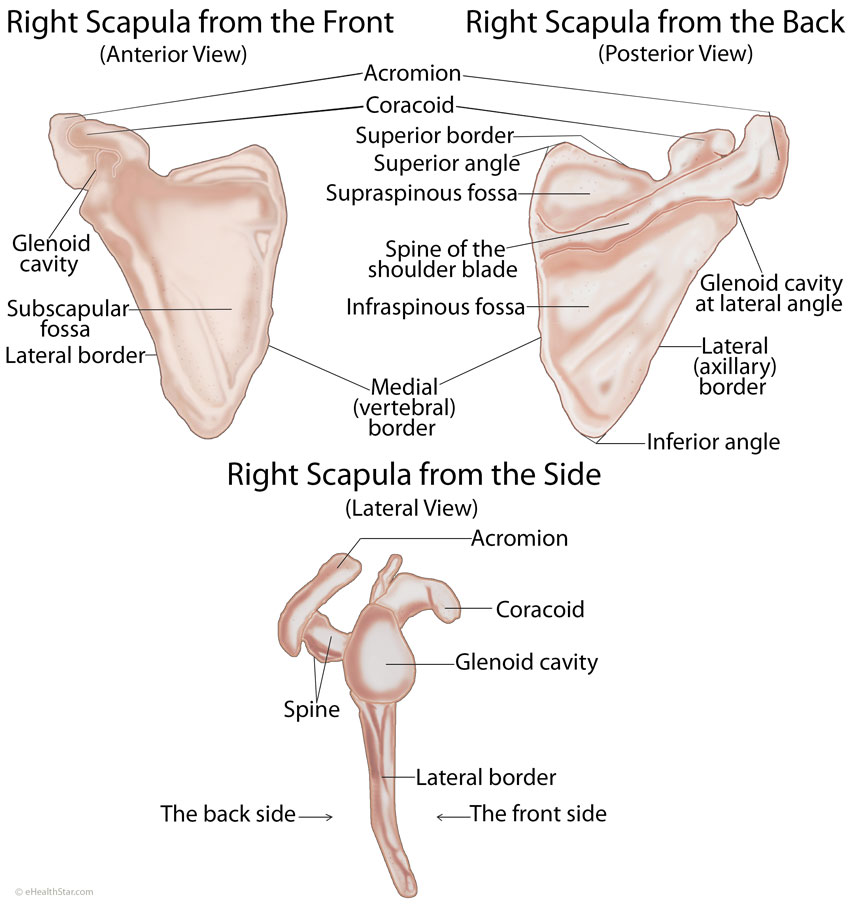
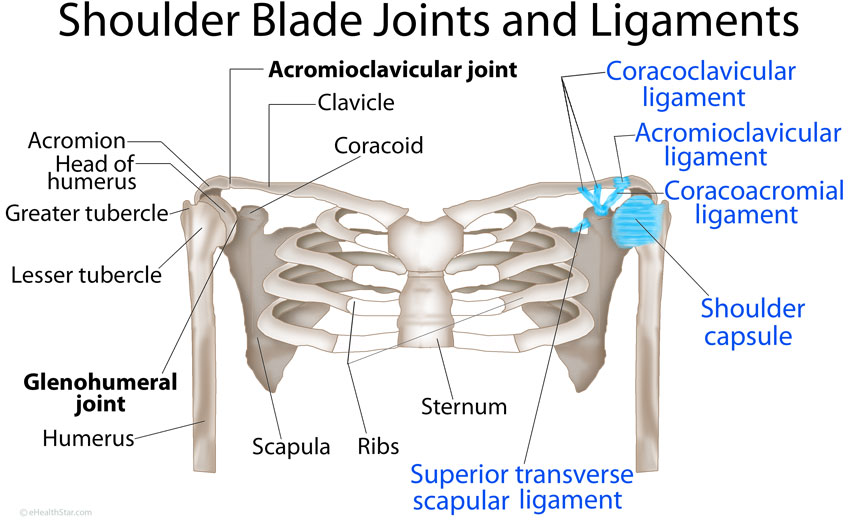
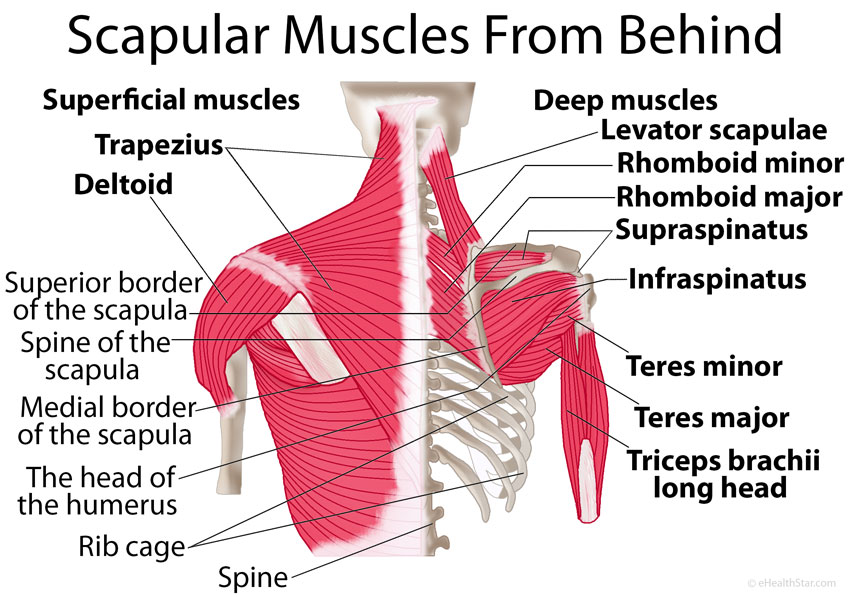
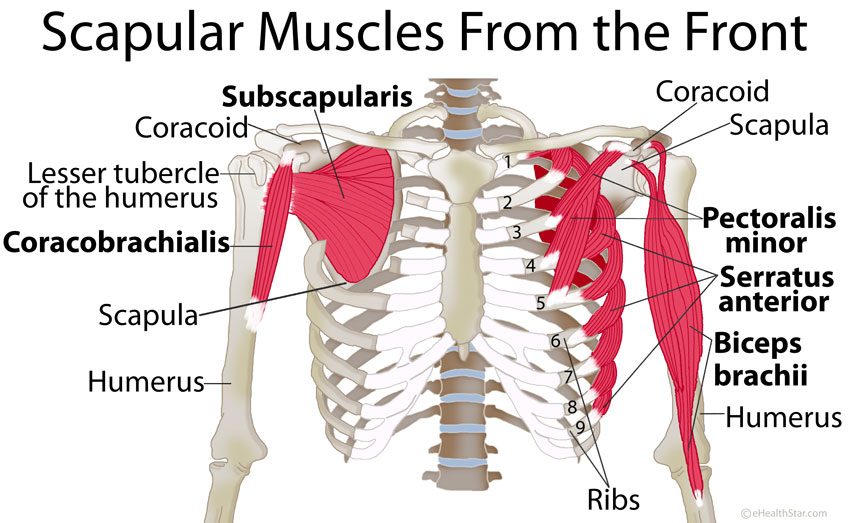
Hi I am a shoulder sleeper.. recently I have pain on my right shoulder muscle and pain in my upper arm, a burning achy pain.. shoulder muscle is the same. I can move my arm with no problem.. I have tried heat, it has helped feels better then it all of sudden hurts all over again.. I have not slept on my side for a while. What should I do? I have no back problems.
Any neck pain?
No neck pain.. it’s the muscle at the top of the shoulder and the top upper arm is achy.. no pain when I move my arm. Should I appy heat or ice?
What you might want to try is releasing tension in the muscles in that area. You can use a lacrosse ball but if that is too hard try a tennis ball. Put the ball against a wall and lean back into it on the tight (painful) muscles in and around your shoulder. The concept is like giving yourself a deep tissue massage. Simply applying heat or ice won’t solve the problem. You need to break up the tight muscle tissue and allow more blood flow into the area in order for the muscles to relax and heal.
Lacrose balls may help in myofascial pain, but can be harmful if it is an underlying nerve problem, so I would not try this.
If you don’t recall any injury or overstretching, then it may not be a muscle problem and heat or ice may not help. The pain at the top of the shoulder and upper arm can arise from a herniated disc or other causes of shoulder pain.
Thanks for this great article;
I am 27 y, I have a winged right scapula, because I have muscles atrophy in 4 muscles right trapezius, levator scapula and rohomb). Due to that, one of my bones in the thoracic spine has been partially slipped to the left side, doctor told me I do not need surgery, otherwise, I am going to increase my muscles around the right scapula to force the bone to back to its position. Now, I can not raise my right hand, I started psh therapy, now I can raise my arm a little bit. But doctor told me not to do work out. I need your help, is there excercise that strengthen muscles around right scapula?
If the doctor said not to do exercises, then that’s it. If you do not trust him, ask another doctor (preferably an orthopedist) for a second opinion. It sounds reasonable to me to not do exercises when you have a problem with a spinal vertebra. You did not say what is the cause of muscle atrophy, though.
Thanks for your reply, I trust him, but I am feeling some disappointment because I cannot workout. I want to do some extra exercise to increase muscles around scapula to recover quickly.
Reason of muscles atrophy is unknown, some doctors told me that, when I was a baby, someone grabbed me suddenly which prevented blood to transfer the enough feeding to those muscles.
The problem with workout is that it might be harmful for your spine. You may want to do this:
– You can ask for a referral to a specialist, probably an orthopedist or neurologist (ask your primary doctor) and discuss is it any investigation possible that would reveal an exact cause of muscle atrophy: impaired blood supply, nerve damage or something other and if there is any effective treatment/surgery available.
– Ask the same specialists if they agree with exercises and if is it ok to do them with your current physiotherapist.
Hi.
I am having an issue with my left scapula. There is a constant ache coming from the medial tip area. The scapula also clunks if I depress my shoulder blade. I have been doing exercises for approximately 6 months to strengthen the muscles around this area but have not had relief. If a finger is pressed against the medial tip during depression it can feel the scapula push down and clunk. Almost as if it is popping over a mass.
Could this be a bursa issue or something else possibly?
It might be bursa, malpositioned scapula or something else what an orthopedician can tell. I do not recommend you to to any exercises before you get an exact diagnosis.
Hi
I am 27, I have been both winged scapula pain since two years. I am getting pain right shoulder and left shoulder and ribs i am suffering a lot even i can’t get relief single minute and also I took physio therapy but it didn’t work out . please give me a suggestion .
Did the doctor say what was the cause of winged scapula?
i am sixty two and have Ankylosing spondylitis i take injection twice a week i have taken them twelve years now but i have the same in my left shoulder blade it has been a year our longer i have had steroid injection but did nothing i carnt stand the pain muh longer i work in school kitchen i am finding it very hard now i have never been out of work i get so tierd know
I was told I have osteoarthritis in my 3/4 4/5. I have horrible pain and numbness. Along the shoulder blade, between spine and shoulder blade, on top and under armpits around the rib. Pain goes down my arm and my arm goes numb. My arm is weak like I’ve lost strength. I’ve done physical therapy, Motrin, Tylenol and just finished a round of prednisone. I really don’t want to do pain meds or muscle relaxers. I’m 60 years old. What should be my next step? Pain gets so bad sometimes that I feel like I’m going to throw up. Any help is greatly appreciated
You can discuss with a doctor (an orthopedist) if there is anything you can do (body posture, using a different pillow, etc.) to prevent your pain. If not, you can ask if surgery could be good for you.
Hello, I’m 31 years old and have been in chronic pain for 9 months. It started in the third trimester of my pregnancy. I’ve had MRIs and Xrays done of my lumbar and thoracic spine. I continue to tell my doctors that the pain in my spine is not nearly as bad a the constant pain in my left scapula area. I get daily massages, use a therapy hook, and take pain medicine, but no matter what I do, the pain never gets better. The only time I have relief from it is when I’m laying down, but that’s nearly impossible to do when I am a mother of 3. It feel like it’s under my scapula where it can’t reached with massage or a therapy hook. I need answers. Please help me so I can suggest this to my doctors at my next visit.
Any other symptoms, like pain in the neck or tingling in an arm?
Shockwave Therapy will solve the problem.
Did you figure out the cause?
I am the caregiver for a 76 yr old man. He was in a horrible accident when he was in his 20’s. Which left him in debilitating pain. He has been on narcotics for over 40yrs and is monitored by a pain doctor and has been able to keep his pain level in check. Over the last few months he began complaining of debilitating pain on his left posterior shoulder blade, however when he actually showed me where the pain was it was just below his left shoulder blade. It is not a constant pain but when it occurs (3-4 times a week) he is completely debilitated. The first sign of this pain was when he was pushing a grocery cart. My question is what is the medical term for the area and can you suggest what might be the cause. As I mentioned before his back was broken in 9 places and was in physcical therapy for years, I am very concerned because it took many many years for his to not only accept he will never be 100% pain free but also learn how to tolerate moderate pain for the remaining years of his life. I am planning on taking him to an orthopedist within the next month or so, (appts in todays day are very hard to make without a significant wait). any information you can give me will greatly be appreciated. Sorry for the long email I want to make sure his history age and discouragement are evaluated along with some quality medical advise.
The area below scapula is just this – below scapula. A doctor can understand the problem better, if the man can answer this:
— Is the area tender to touch (which exact area: back, side of the chest, neck, shoulder, arm)?
— Does moving an arm in different directions or lying down aggravate or relieve the pain?
— Any numbness/tingling in the back or arm?
— Was the onset of pain sudden, that is directly associated with moving a cart?
— What were the exact injuries he had (named with the exact words used at the time of diagnosis)?
One possible cause of pain is a pinched nerve in the thoracic spine, maybe due to a herniated disc. This can be seen on an MRI but not on an X-ray. An orthopedist can make some simple tests to narrow down the cause. I suggest a visit to a doctor soon.
I have learned so much from your website,thank you,more power,and GOD bless you!
Great site! I was taking a shower last Friday morning when I thought a pinch nerve was ready to set in. Went to work and left after only 1 hour. It never turned into a pinched nerve but the pain remained and is only worse 8 days later. Full movement but with pain no matter what position I’m in. There is no moment without pain. I’m 47 with chronic back pain for past 30 years and regularly take tramadol and rarely muscle relaxers. If I take 1 team with 1 muscle relaxers and 4 ibruprofins the pain resides for few hours. Pain feels like it’s coming from underneath edge of upper inside right scapula. Please help. Would predisonilone help relieve pain?
The pain along the medial border of the scapula can arise from a herniated disc in the neck, that results to a pinched spinal nerve. This can also cause the pain in the shoulder and outer side of the upper arm. The pain can be aggravated by bending the neck backwards and relieved by putting the hand on the affected side to the top of the head. More common causes include a muscle cramp or stretched muscle.
A positive Spurling test speaks for a herniated disc. If the pain continues, you may want to see an orthopedist.
no fever, no headaches, just lay on my left side cant sleep on my right also im almost bedridden as cannot walk! lately ive had a chronic pain at the back near my shoulder blade lung area i also have a mucus cough which seems to come from my left lung! im wondering if this is due to the sleeping constantly on my left side im female 80 this year or something more sinister ive deffinatly no feeling of severe pain i suffer with gout can gout get in that area or gas ??dont smoke now for 20yrs? please can someone enlighten me? God Bless
Eve, a doctor can tell if the mucous cough is from pneumonia and if it causes pain in the shoulder blade area.
Great website. I am doing research on the shoulder itself, the bones that make it up, ligaments, tendons and muscles that are apart of it. I guess just the anatomy of the shoulder, its components, articulation, common injuries and their causes and fixes. If you have any recommended websites to look at for much needed information that would be wonderful. Thanks!
Lex, first we have these articles:
Shoulder muscles anatomy (with links to individual shoulder muscles)
Shoulder (pectoral girdle)
Shoulder blade pain (causes with description)
For other websites just check what we have in the References sections below the articles.
Its a very good website
I’m having pain in the area of my shoulder blade. It’s hard to move my arm. Hard to breathe. I have complete range of motion, with some pain of coarse but.I can still move my arms in a full circle form. It hurts to lay down on the side of the pain. And it’s hard to lay down and get up in bed. I have no received Amy severe impact Altho I have been.sleeping on.my arm a lot and cleaning. Is it broken of sprained? Fracture? Or did I pull a muscle or something. Any advice?
Karina, you did not tell how old are you. If you are older, even average physical work can result in a muscle tear. Muscle tears in the shoulder area less likely result in difficulty breathing, though. A lot of cleaning work can affect the muscle called serratus anterior and cause pain during breathing and arm movements. Such pain usually goes away on its own with some rest.
Difficulty breathing with feeling ill coughing and/or fever can be from pleurisy.
Dear Jan Modric
Thanks for the good work on ehealthstar.com
I kindly ask for permission to use Picture 3 (Scapula anatomy diagram: parts of the right shoulder blade:
anterior, posterior and lateral aspect) from this website in my report.
I just want to illustrate the different parts of the scapula as presented.
Kind regards
Wasswa, yes you can use this image or any other image in this or any other article on ehealthstar.com you want. If you will put it on some website, I would be happy if you give a live link to the article.
Three weeks ago I was out shopping carrying a heavy purse usually on the right shoulder. I felt a tightness start in the top of my spine/neck. By the time I reached home it felt like a catch had begun tightening up in the right shoulder. After three weeks it is extremely painful with little pain free hours. I have used ice and heat off and on. It helps but not for long. I have been taking 3 advils every 4 hours and sometimes it works. I just had a steroid shot for a herniated disc. So the exercise gig has been out for months. I’m in my sixties and need to know how to treat this or should I see the Orthopedic.
Charlotte, seeing an orthopedist is a good idea. The pain can be related to a herniated disc in the neck.
I am a 60 year old male who hasn’t been in the gym for 25 years. I am experiencing a sharp pain between my scapula and my spine ( closer to my scapula). Pain level is a solid 7. If I push on that area, it’s a solid 9. I do a lot of lifting at work and in my personal life. What do you think I did? HELP!
Paul, the common cause of such pain is muscle strain; it may be also a muscle rupture. I can’t exclude an injury f your spinal vertebra or nerves, so you may want to see a doctor. Avoid any lifting or carrying anything heavy.
I need free advice from a good doctor help! I dislocated my shoulder and since it was reduced the bad side the scapula is no longer prominent. and it is quite raw when I get touched in the area. the doctor said it wasn’t broken based on the ER xrays which were side views so I don’t understand how he determines that, but he says its ust atrophy but how can a muscle atrophy instantly after a shoulder dislocation, I am not a quick thinker so I just agree with the doctors while I am at heir office. but I think the muscles have actually slipped off the scapula because it is really bony, while my good side is nice and meaty. also it hurts if I sit in chairs now my scapula. don’t understand why its flat. when I press my back against the wall and I raise my good arm both shoulder blades touch the wall but when I lift my bad arm that shoulder blade doesn’t stay flat against he wall. same thing trying to sleep I cannot raise my arm above my head because it won’t lay flat on the bed, I have to but a bunch of pillows under my arm and that is only comfortable for a few minutes. I was thinking my reduction at the ER WAS DONE IMPROPERLY but I don’t know since I asked for drugs to knock me out because I was in so much pain by the time the ER doctor could do anything 5 hours later. but somehow my scapula is not right anymore at least the muscle movements. Wish there is a way to manipulate he muscles back to their original position without surgery. is that possible?
Rob, it is possible you have a condition that affects your shoulder muscles or the nerves that supply those muscles. It is an orthopedist or neurologist who can help. It is possible that muscle atrophy was the cause rather than the result of shoulder dislocation.
right shoulder blade pain.. vey agitating … need relief… over sixty years old …
Calvin, I would need more information to be able to help.